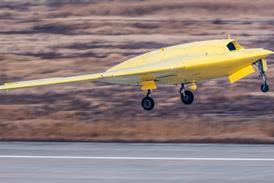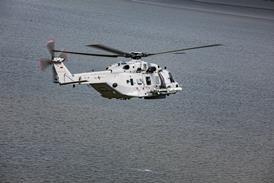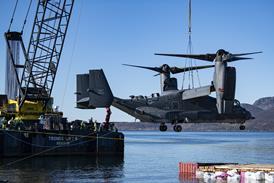Drone use – both commercial and recreational – is on the rise in the UK, and, more worryingly, so is the frequency of airprox events involving unmanned air systems.
Reports submitted to the UK Airprox Board show an upward trend.
In fact, encounters have risen from zero five years ago, to 93 in 2017; in the first six months of 2018, 35 such events were recorded, according to the Airprox Board data.
And FlightGlobal analysis of Airprox Board data, covering the period from 1 January 2017 to 30 June 2018, shows that the vast majority of incidents are classified with the highest level of risk: the ICAO ratings of A, B or C.
Over that 18-month period, there were 44 category A incidents, 41 category B, and 42 category C.
But, as with much about drone use in the UK, there are a great many unknowns. For instance, as the UK Civil Aviation Authority admits, it has no knowledge of how many recreational drones there are in circulation.
Anecdotally, sales of the sort of over-the-counter quadcopters that can be acquired for a few hundred pounds are on the rise, but it has no firm statistics to back this up.
Performance is also an issue: although UK regulations on consumer drone use prohibit operation above 400ft, many have a service ceiling significantly above that.
For example, the DJI Mavic Pro drone – which although not cheap, is still under £1,000 ($1,300) – has a claimed service ceiling of 16,400ft, while its bigger brother – the Phantom 4 – can reach up to 19,700ft.
Both those drones, used irresponsibly, are more than capable of operating at the sort of altitudes used by air traffic, whether that is transiting general aviation flights or commercial aircraft departing from or arriving at an airfield.
Analysis of the Airprox Board data shows almost half of drone encounters, or 48%, were at altitudes below 2,000ft, with a further 22% between 2,000-4,000ft.
Since July, the operation of drones has been prohibited anywhere within 1km of an airfield boundary, but that on its own is unlikely to prevent further incidents.
The CAA has been conducting an extensive education campaign, dubbed Dronecode, aimed at consumer drone users with some success: its surveys show that there is an increased level of understanding that there are regulations in existence, and the detail of those rules.
However, it acknowledges that there are still drone users out there that do not know there are rules, do not know the rules, or what it describes as a small percentage of users who know the rules but choose to actively disregard them.
“Anyone operating a drone must do so responsibly and observe all relevant rules and regulations," says the CAA.
"The rules for flying drones are designed to keep all airspace users safe. It is totally unacceptable to fly drones close to airports or aircraft and anyone flouting the rules can face severe penalties including imprisonment."
Reading through the Airprox Board's verdicts on drone encounters, a number of phrases crop up time and again. Among these are the determination that an unmanned air vehicle has been flown beyond the limits of visual-line-of-sight operations "such that it was endangering other aircraft at that altitude and position".
In addition, what also appears with alarming frequency is the belief that "the drone was being flown in the vicinity of an airfield departure lane such that it was endangering other aircraft at that location and altitude".
As a current Department for Transport consultation on drone regulation notes: "The [UK] government has consistently reinforced the message that drone flights should take place far away from aircraft, however, a small number of people continue to fly drones close to aircraft and airports."
A further issue with the source data also exists. With a regular airprox event, the Airprox Board should have a version of events from the pilots of the aircraft involved, plus that of the air traffic controller and relevant radar returns.
But with an airprox involving an unmanned aircraft – whose controller is unknown and when there is no radar data – the Board is forced to take the pilot's version of events at face value, in an event where they may only have glimpsed an object for a few seconds at an uncertain distance.
Despite all this, there are several incidents recorded where a collision has only been narrowly averted. In one, the pilot of an Airbus A319 said he felt that lives were put at risk after a 1m-diameter drone passed between the wingtip and the fuselage as the twinjet made its final approach into London Gatwick airport in July last year.
And in another 2017 incident, a drone passed so close to the cockpit windows of an A320 landing at London Heathrow that the crew were convinced that it must have struck their aircraft's tail. However, no tangible evidence of collision was found by a post-landing inspection.
Although research argues that collision with a drone should pose no threat to the safety of the commercial airliner at take-off or landing speeds, other aircraft – notably helicopters – are much more vulnerable, the DfT suggests.
A CAA analysis published earlier this year suggested that collision with a typical drone weighing under 2kg (4.4lb) would be unlikely to cause significant damage to a large jet engine. And while a windscreen of a commercial airliner could be seriously damaged, it is certificated to withstand the impact of a 1.8kg bird at cruising speed.
Windscreens of small helicopters and general aviation aircraft, which are not required to pass bird-strike tests, are susceptible to damage, the CAA says, while helicopters generally "face more particular risks because of the additional susceptibility of rotors to damage from a collision with a drone".
Modelling work conducted by the US Federal Aviation Administration also suggests that "drone collisions cause greater structural damage than bird strikes for equivalent impact energy levels." This is likely due to their rigid structure and dense components, such as the batteries or motor.
But as with much involving drones, until more real-world collisions occur – just seven had been reported globally by January this year – the outcome will remain uncertain.
Source: FlightGlobal.com


























